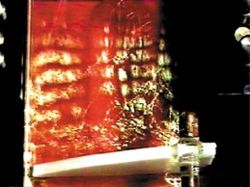Supple Electronics
Research into the chemistry and physics of supple
electronic materials and devices constitutes a major interdisciplinary theme within the
department. Organic, inorganic, physical and theoretical groups within the department, as
well as other groups from engineering and physics, are working together to fabricate a
broad class of novel electronic devices. These include: self-assembled networks of
molecular switches and resonant tunneling diodes integrated with quantum wires;
organic-derived photonic devices such as photovoltaics and light-emitting diodes; and
acoustically modulated optical switching crossbars built from quantum dot superstructures.
Other related areas of research include photonic band gap materials, switches based on
magnetoresistive elements and single electron charging devices. |

A Langmuir monolayer of silver
quantum dots that is undergoing
an acoustically generated, reversible metal/insulator transition.
This technology, which is being developed in the Heath
and Levine laboratories, may be used to fabricate vastly
improved optical switching networks.
(C.P. Collier, S. Henrichs and J. Heath;
image by the UCLA Visualization Lab.)
|
![]()